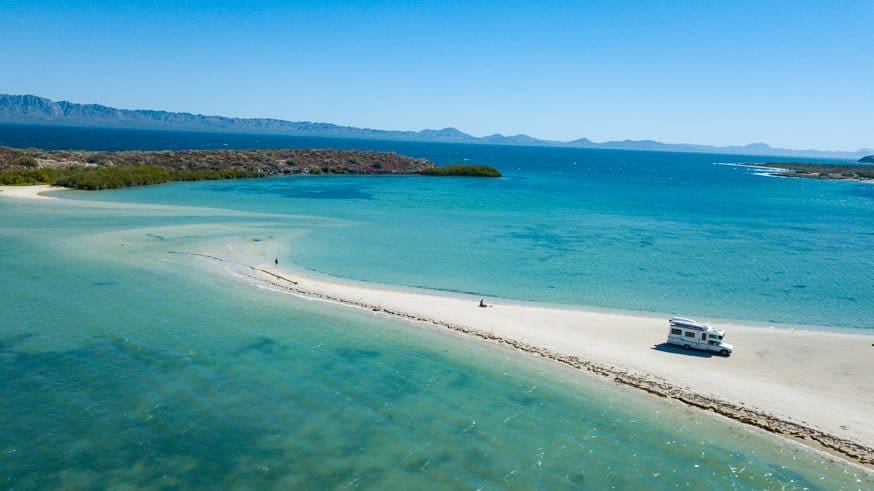
Flanked by the big surf of the Pacific Ocean and the tranquil Sea of Cortez, with three mountain ranges and a cactus-studded desert running up the middle, Baja is what camper dreams are made of! With basically one main road escorting you to the big highlights and a few dozen spurs into unspoiled wilderness, it’s as easy or adventurous as you want it to be.
Even though we have spent extensive time in Mexico (housesitting, vacationing, even road tripping) and consider this country one of our favorites in the world, we were a little nervous about RVing Baja. This is in part because Mexico is often portrayed as “dangerous” in the news, but also because we didn’t know if our slapdash RV style would fly. We wild camp in the middle of nowhere, drive well past sunset, and own a vehicle you could break into with a can opener. When we realized these were our own problems and ones we could easily fix, it was time to discover the Baja magic!
Our Baja Road Trip Route
Over a three-week, 2,100-mile road trip, we traveled from the laid-back border town of Tecate to the wine country of Valle de Guadelupe, the seaside resort town of Ensenada, then rode Highway 1 into Desierto Central’s cactus-studded mountains. Six days into our journey, we crossed from Baja Norte into Baja Sur (the peninsula’s two states). The southern half is where the marine life really ramps up—from the gray whale calving lagoons on the Pacific side to the UNESCO biosphere islands of the Sea of Cortez. Plus, Baja’s Spanish colonial heritage shines. Eighteenth-century missions made mountain hamlets and beach towns far richer, and the areas where the Spanish didn’t build have barely been touched.
Bahía Concepción has some of the prettiest beaches and not a single chain hotel! Driving from the Pueblo Mágico of Loreto, there is a bit of a lull, but when you reach the city of La Paz and its surrounding islands and mountains, it’s wondrous all over again. Greater La Paz was even worth hopping out of the camper for a few days of island glamping on Espíritu Santo and a rancho homestay in the Sierra de La Laguna. (If you want to carry on farther south, check out this blog from a previous trip around Los Cabos.) Read on for our favorite tips from roads less traveled.
Baja Camping 101
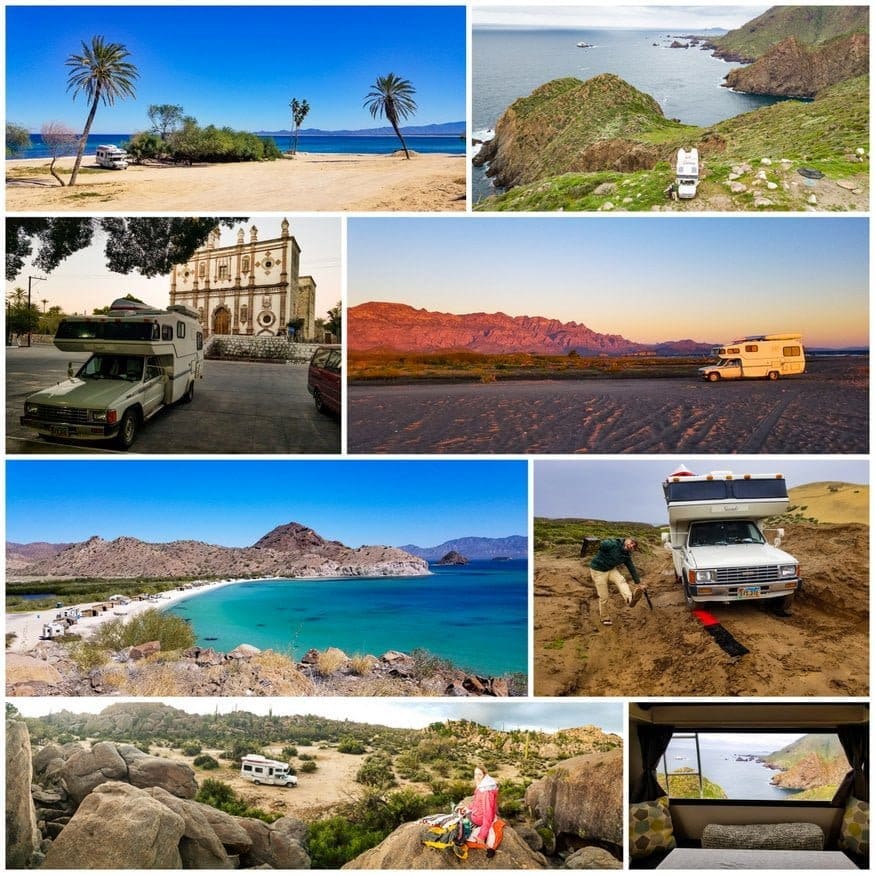
Let’s start with the basics of camping in Baja. The average cost of an ocean-view campsite is around $7 and is quite often free. To discover them, start by downloading the iOverlander app. This led us to a variety of gems, from secluded sand dunes to family-owned restaurants that let you stay in exchange for buying a burrito. The app also maps out where to find propane, fresh water, showers, dump stations, and more with its handy filters.
If you like the social aspect of camping, check out the VanLife app or Xscapers to connect with fellow adventurers. FYI, camping on our own always felt totally safe and serene. To help make this happen, we didn’t drive after dark, read the comments for each iOverlander listing, and stopped going down dirt roads if rain was in the forecast (after we LEARNED THIS THE HARD WAY!).
BAJA NORTE
Tecate Border Crossing
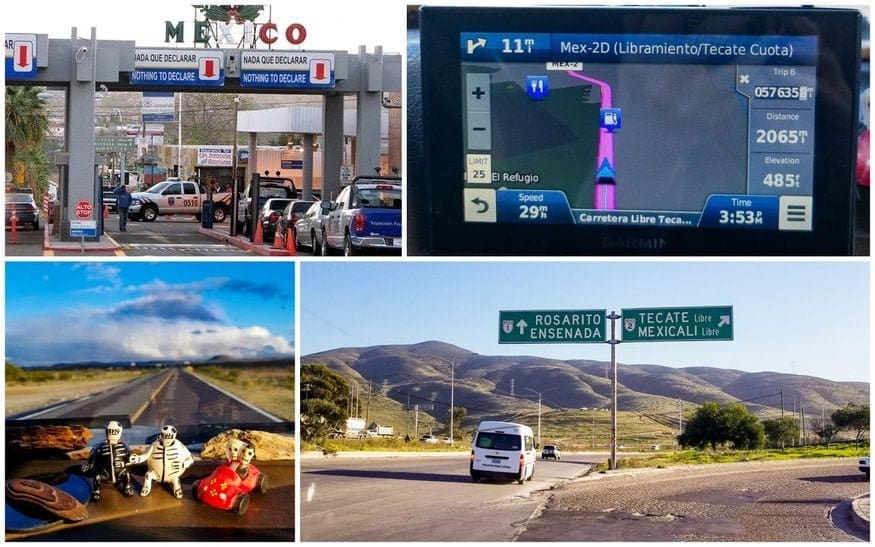
Instead of entering Mexico via the busy Tijuana crossing, we went 45 minutes inland to Tecate. This town is not just the home of Tecate Brewery, but it is a Pueblo Mágico (a special designation for Mexico’s most culturally rich and historic towns). There was one car in line, and when it was our turn, the officer only asked for our car registration (not even our license or passports!) and to take a glance inside the camper before he sent us on our way.
While we kept driving to make sunset in wine country, we would recommend staying a night in Tecate to get your Mexican bearings and enjoy its traditional town square, 1,500-year-old cave paintings, and tour the peninsula’s most beloved brewery.
Valle de Guadalupe: Wine Country Camping

Highway 3 carries on through beautiful mountain passes to Valle de Guadalupe’s “Ruta del Vino.” The region has been making wine for over 100 years, but the industry only started booming 20 years ago. Today, there are more than 150 wineries, making it the “Tuscany of Mexico.”
For our first night in the country, we seized the opportunity to use our Harvest Hosts membership and camp at a winery (free of charge in exchange for buying a bottle). We pulled into L.A. Cetto just as the sun was hitting the mountains and casting its glow on their 4,000 acres of vines. Save for a security guard looking after the place (gracias, señor!), we had the entire place to ourselves. The next day, we were happy to repay one of the country’s oldest and largest wineries with a tour and tasting. We’d also recommend Las Nubes and Bar Bura, not just for their wine but for their views of this gorgeous region.
Punta Banda: Hot Springs & Marine Geysers

Less than an hour south of Ensenada (home of the original fish taco and Baja’s oldest cantina, the great Hussong’s), lies our favorite sliver of the far north: Punta Banda peninsula. It is full of natural wonders, starting with its hot spring beach! At low tide, you can see steam rising from the sand—those are your hot spots and where you want to start digging. We plunged our shovel (see our Baja packing list below) and 100-degree water bubbled up! In just fifteen minutes, we had a natural jacuzzi with views of the bluffs! Could Punta Banda get any better? It did.
At the tip of the peninsula, we found Campo El Mirador, a campground on a mountain spine that drops to the sea and the famed La Bufadora marine geyser. At high tide, this blowhole shoots water up to 90 feet in the air! From your campsite, it’s a gorgeous hike through coastal succulent gardens and is free when you arrive on foot!
Hot Springs Intel: There is no name or sign for Punta Banda’s hot springs. This is what RVing Baja is all about! To get there, follow these GPS coordinates (31.7167, -116.6661) and park at the mini mart (good to buy some cervezas from them to earn your spot). On the right, there is an unassuming, long, narrow path between properties that leads down to this delightful public-access beach!
The Otherworldly Desierto Central
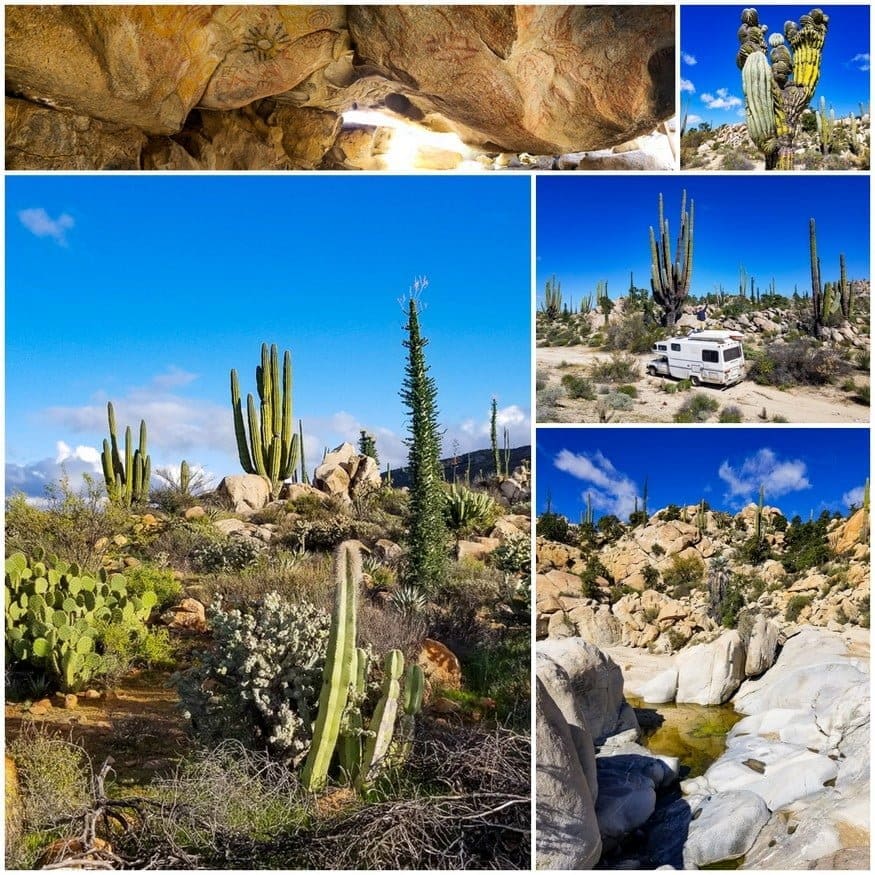
Baja’s tourists generally stick close to the border and Los Cabos in the far south, but little do they know that Baja’s most iconic beauty lies in the middle. The Valle de los Cirios is the second largest protected natural area in Mexico, spanning from coast to coast all way to the state line with Guerrero Negro. Towns vanish, and cacti are the new skyscrapers. Fifty-foot-tall cardons, Dr Suess-like cacti, pink barrel cacti, and boulders are strewn about the sierras.
The first sign of civilization you’ll encounter is one created 1,000 years ago by the Cochimí people at the incredible Cataviña cave paintings. We took the short, steep hike and ducked into the ancient art gallery. Spared from wind and rain, the ceiling retained its vibrant depictions of dancers, animals, and geometric motifs. Rather than hike back the way we came, we climbed down the backside to the river valley for some fun rock scrambling among this palm-tree oasis.
Connectivity Tip: There is no cell service between El Rosario and Guererro Negro. Hotel Mision Cataviña offers WiFi by the hour, plus a decent restaurant, bathrooms, and a beautiful cactus garden.
BAJA SUR
Ojo de Liebre: Communing with Gray Whales
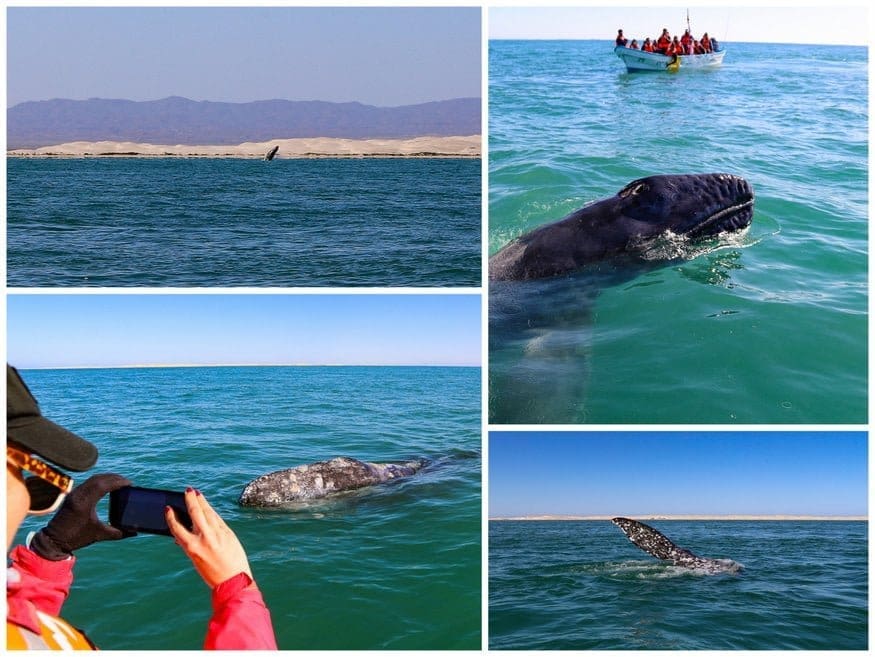
In addition to warm weather, gorgeous scenery, and fantastic people, the reason we came to Baja, Mexico, is for the one-of-a-kind whale watching. Each winter, hundreds of gray whales migrate from their feeding grounds in the Arctic to their breeding grounds in Baja. They come to birth and raise their calves in three Pacific lagoons: Magdalena Bay, San Ignacio, and Ojo de Liebre. With whale hunting a thing of the past, generations of whales have come to see boats and humans as a chance for friendly interactions. It seems unbelievable, but mothers actively encourage their babies to approach panga boats!
So excited by this prospect, we seized the first whale-watching opportunity on our route. Leaving from Guerrero Negro with Mario’s Tours ($50 for three hours, plus lunch), eight of us hopped in a little boat and cruised along the sand dunes until we got to Ojo de Liebre. We saw whales spouting off in every direction, and with patience, a mother and calf came to play with us for 25 minutes (and we caught it on video!). Spyhopping and diving just inches from our boat, this was by far the most intimate whale encounter we have ever had. Though speaking of intimate, we later saw three whales rolling around in a courtship ritual!
Whale Watching Tip: While we loved our experience out of Guerrero Negro, the town of San Ignacio is a much cuter basecamp (a Spanish colonial charmer) and supposedly their lagoon has even friendlier whales!
Don’t Miss These Spanish Missions
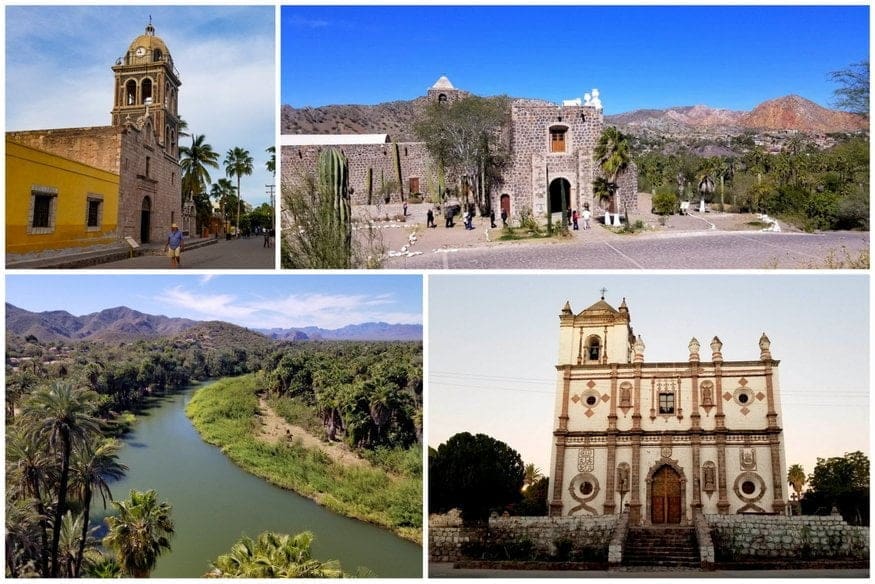
Heading out to the Sea of Cortez, incredible Spanish colonial missions begin to appear. Starting with Misión San Ignacio Kadakaamán, you’ll drive alongside gorgeous palm-lined lagoons, and this stone beauty from 1728 appears in the heart of San Ignacio village. At the start of Bahía Concepción, the expat haven of Mulegé is great for getting gringo comforts and propane refills and, of course, its mission. Tucked high above town and up a snaking side street, it’s easy to miss but well worth the effort to see this foreboding structure overlooking the river and sea. (Interesting fact, it doubled as a stronghold in defeating the invading Americanos during the Mexican-American War of 1846-1848.)
Further south, the 17th-century Misión de Nuestra Señora de Loreto Conchó is the first mission the Spanish built in the region, making it the mother of all Baja and Alta California missions. If you have the time, Misión San Francisco Javier de Viggé-Biaundó is an hour off the main road from Loreto and supposedly the prettiest of them all!
Santa Rosalía: French Baja
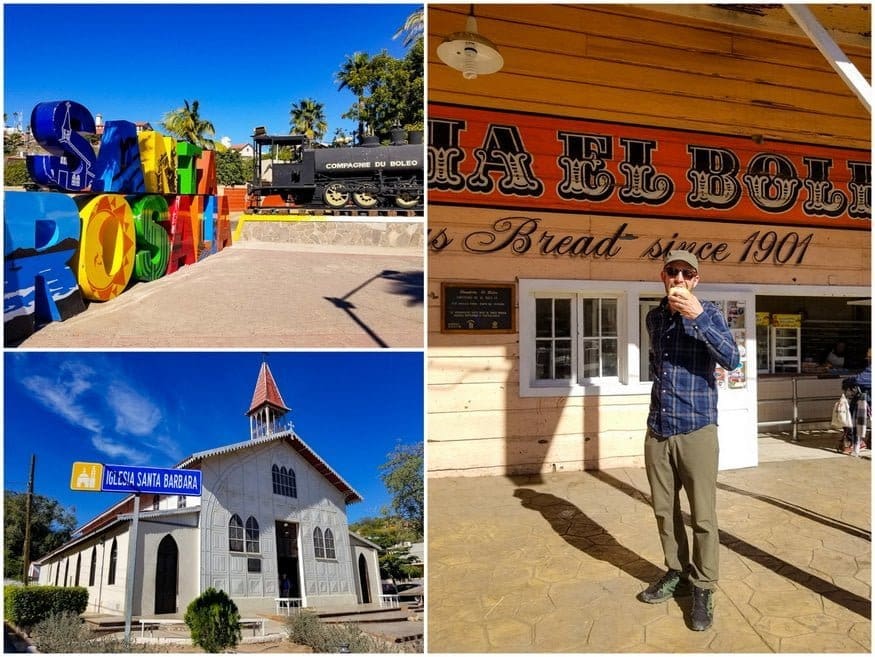
Santa Rosalía is the first real town when Highway 1 hits the Sea of Cortez, and while it’s far from the prettiest, it is the quirkiest. It was started by a French mining company in 1884, so the architecture is unlike anywhere on the peninsula, with its ornate wooden homes and a metal church designed by none other than Gustave Eiffel of the Eiffel Tower fame.
The owner of the mining company snatched it up after its appearance in the World’s Fair and had it flat-packed on a boat to Baja to bring some religious sophistication to town. He also made sure they had a quality French bakery—the one and only, El Boleo. We followed our nose to this institution, and a worker motioned us over for a behind-the-scenes tour of their pastry chefs making the original recipes in the 19th-century stone ovens.
Bahía Concepción: The Best of Baja RV Beach Camping

When you see those idyllic photos of Baja with turquoise waters, cactus-studded islands, and white-sand beaches, it’s probably somewhere along Bahía Concepción. While there are surprisingly few tourists, there are a few enclaves of snowbirds that have it all figured out. When we got to Playa Santispac, this beach cove dotted with islets took our breath away, as did the volume of RVers.
We would normally be turned off by such a crowd and a $10 camping fee, but something interesting was happening here. This was a world unto itself where over 100 retirees set up camp for months at a time, completely cut off from the outside world, with nothing but this stunning beach, the facilities of their RVs, and one rocking bar.
After a glorious kayak around the islands, we walked the beach chitchatting with people from Alberta, Michigan, and virtually every cold-weather region in North America. Then the music sparked up! Turns out, the original Van Halen drummer winters down here and he’s formed a solid local band. We may have been 25 years younger than anyone at this party, but they were dancing us under the table until Baja Midnight (9pm) and rewriting the definition of a retirement community. For something more chill along Bahía Concepcion, Playa El Requesón is a stunning spit that fans into two coves, and beaches like Playa Armenta are plenty beautiful for the price of free.
Kayaking Bahía de Loreto National Park
View this post on Instagram
The town of Loreto is a tourist favorite with its ancient mission, ficus-tree archways, and margarita happy hours…but to us, it’s all about the Bahía de Loreto National Park. This UNESCO biosphere reserve and Mexico’s largest marine preserve is ripe for island hopping, scuba diving, and kayaking. For a self-guided kayak adventure, we honed in on Isla Coronado, a volcanic island with beach coves, rock scrambling, reptile spotting (16 species!), and sand spits too shallow to be reached by motor boats.
In the protected bay, there was very little wind, so we cruised alongside the birds, fishies, and bobbing sea turtles. After three miles of paddling, we reached the white sand beach, without a soul on it, and hiked the black boulders to the ridge. On the way home, our arms were feeling the burn, but a sandbar island and the lunch in our dry bag kept us motivated. Our craft skidded ashore, feeling like this low-tide island only emerges for adventurers like us.
Kayaking Tip: For the put-in spot, follow signs to “La Picazon” restaurant and have faith that the long dirt road will get you to a good parking spot (GPS: 26.0897, -111.3256) and a short path down to the beach.
The Road Angels of Lonchería Lupita
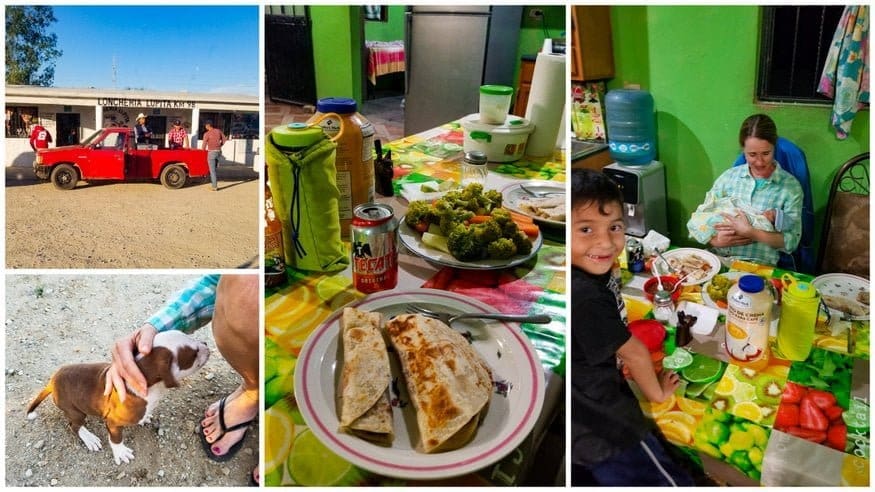
After Bahía de Loreto, Highway 1 does a massive S-curve into the desert abyss until it swoops back out to the Sea of Cortez, and even though it’s not the most interesting stretch, we had one of our favorite cultural experiences here. It was getting dark, so we consulted iOverlander and they listed “Lonchería Lupita” as a roadside cafe that’s friendly to RVers. We arrived as they were closing, but instead of turning us away, the family invited us into their personal kitchen for an off-menu burrito feast complete with a mountain of steamed veggies (a vegan dream!).
While Lupita was preparing dinner, Mike and her grandson invented games with a ball and a box, while I enjoyed a chat with the patriarch. Then, in walks the daughter with her eight-day-old baby. Even though she’d only known us for a few minutes, she put her newborn in my arms as if we were part of the family.
La Paz Carnaval
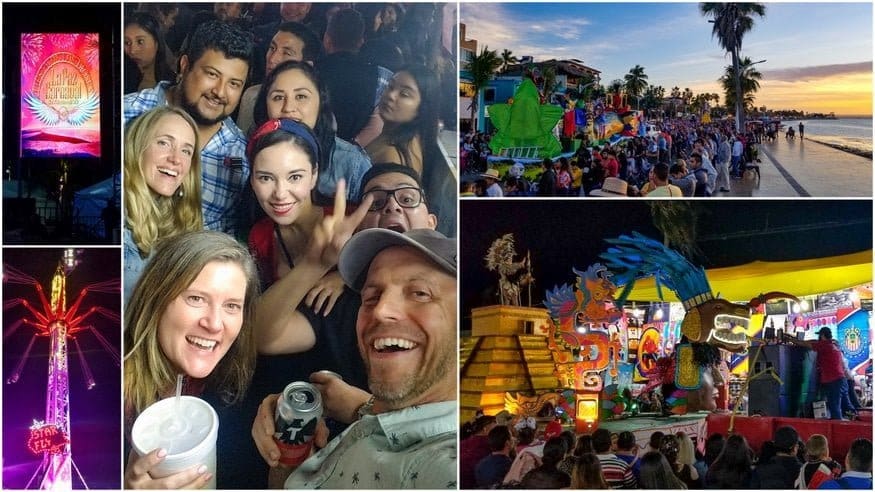
We reached the vibrant city of La Paz just in time for Carnaval! It’s said to be one of the biggest pre-Lent celebrations in the country, so if you’re arriving in February, try to align your trip with the festivities (dates here). This five-day festival takes over the malecón (seaside promenade) with parades, bands, rides, games, and countless food stalls. With our expat friend Kristen Gill as an accomplice, we dove headfirst into the carnival revelry. We cheered on the parade, sampled junk food, drank the legendary Doble Canalas (beer, clamato, and vodka), danced at every bandstand, and rode the swirling swings for 360-degree views over town.
Bahía de La Paz: Snorkeling with Whale Sharks
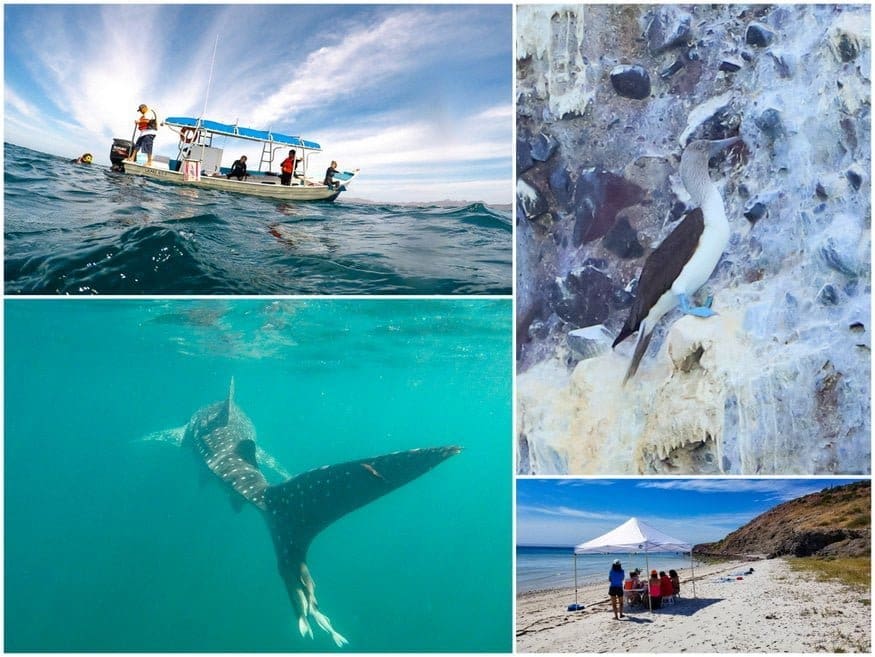
Every winter, upwards of 100 adolescent whale sharks come to feed in the Bay of La Paz. While this happens in various locations around the world, this is one of the most accessible and responsibly managed destinations for these wildlife encounters (read: no feeding or crowding). We went on a full-day boat trip with RED Travel, a Baja leader in sustainable tourism, and it exceeded our expectations.
To make sure the whale sharks have ample space, a limited number of boats can be in the sanctuary at any time. The good news is, “waiting your turn” means a boat trip into the archipelago to see rare birds like the blue-footed boobies, the San Rafaelito sea lion colony, and Balandra Beach (known to be one of Mexico’s most beautiful).
After a whale shark orientation by our brilliant young guide and biologist, Andrea Quintero, we were ready to swim with the world’s largest fish. The main rule is to stay out of their path (as docile as they are, they move like a freight train). We swam alongside a baby, then a 25-footer, marveling at their gorgeous spotted skin, swishing fins, and the symbiotic fishes hitching a ride.
Swimming with Dolphins in Bahia de La Paz
As if our wildlife encounters couldn’t get better, a pod of dolphins was diving around our boat, and our guide asked, “Want to swim with them?” With a heck yeah, we dove back in and were eye-to-eye with a half dozen bottlenose beauties! To end the perfect day, we docked on a deserted beach for ceviche (cod or quinoa style), cervezas, and sunbathing. See this incredible day on film, here.
Glamping Isla Espíritu Santo
Just outside of La Paz, Espíritu Santo is the gem of the Islas del Golfo de California UNESCO Biosphere Reserve. With 891 fish species and 39% of the world’s marine mammal species, it is a wildlife wonderland and unspoiled paradise. Of course, hotels would love to build along its white sand beaches, but Todos Santos Eco Adventures’ sustainable glamping is the only luxurious way to stay.
Featured in our book Comfortably Wild: The Best Glamping Destinations in North America, Camp Cecil earns its spot in the “Safari” chapter and our hearts. During our three days on the island, we cruised alongside dolphins, swam with baby sea lions, and spotted birds rarely seen outside of the Galapagos. Better yet, whenever we sailed or paddled back to camp, fine food and fabulous tents awaited us with big smiles. Watch this video—it’s time to go glamping Baja style!
Ranchero Culture in the Sierra de la Laguna
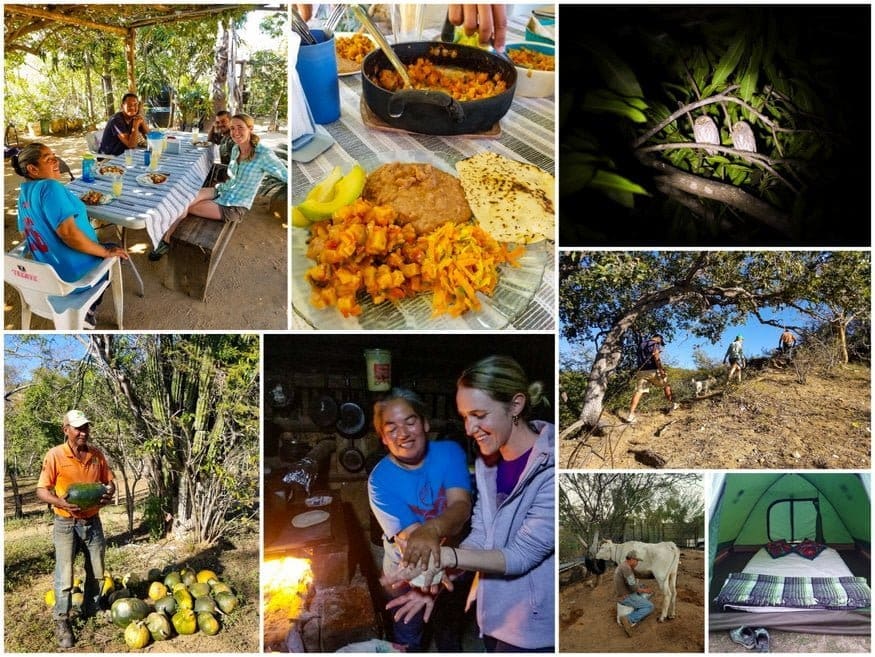
The Sierra de La Laguna is also a UNESCO biosphere reserve, recognized for its contrasting ecosystems and volume of endemic species. Our two favorite tour operators, Todos Santos Eco Adventures and RED Travel, both offer trips here. As tempting as it was to try the brand new Camp Cecil de La Sierra glamp camp, we were excited to try an overnight trip with RED and learn more about their Mexican culture and reforestation programs.
We arrived at the fourth-generation Mesa family ranch and were welcomed with a vegetarian feast. Sitting on their terrace, surrounded by tropical fruits and looking out to the rolling cow pastures, we started to see the interconnectedness of life on the ranch and food on the table.
Tortilla-Making in La Paz
Over the course of two days, Ricardo showed us how to milk cows, and Cristina taught us to turn that fresh milk into cheese. We visited the neighbors, who proudly showed us their thriving vegetable fields. In the evening, we spent time in the thatch-roof kitchen learning the art of tortilla-making, over the same comal Richie’s mother cooked on 70 years ago. As we were eating dinner, our guide spotted a pair of endemic elf owls, and it inspired a nocturnal safari that lasted until 11pm, followed by another birdwatching session at sunrise. Despite its UNESCO status, the Sierra de la Laguna is being threatened by mineral exploration.
To prove that the cultural value of the Sierras is greater than the proceeds of mining, we need families like the Mesas, tour operators like RED, and tourists like you. Check out RED’s environmental and community initiatives here.
Returning North
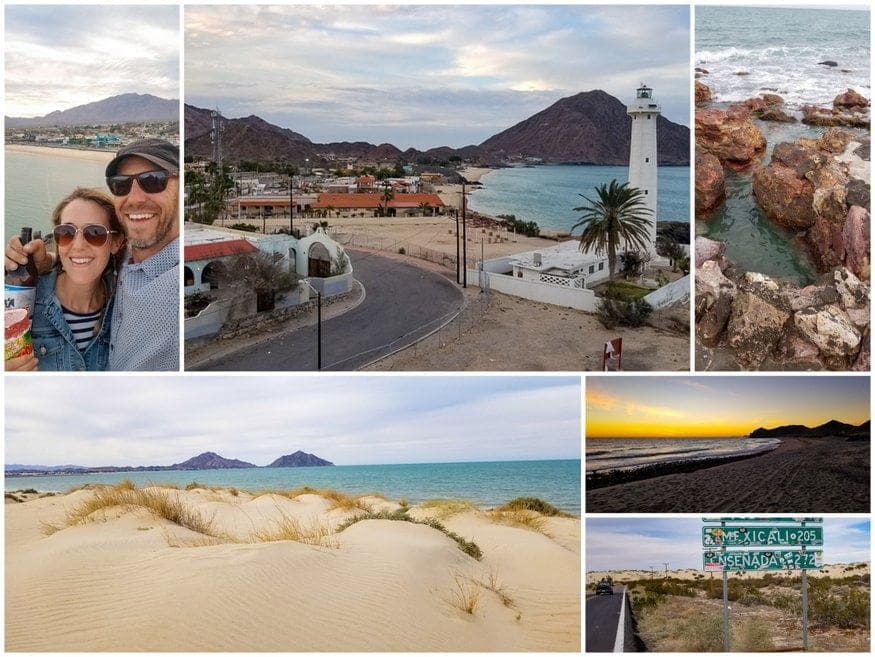
While it could be a bummer to retrace a 1,000-mile route, Baja is so gorgeous it’s worth a second pass. Plus, the recently paved Highway 5 makes it easy to switch things up with a drive along the Sea of Cortez to the Mexicali border. We cruised into the desert abyss, then Gonzaga Bay appeared like a mirage. Big mountains, sweeping beach coves, and islands spiking out of the sea, it was Baja at its rawest beauty. We pulled into the Papa Fernandez campground, where they charged us a whole $5 to camp on a million dollar beach (GPS: 29.8321, -114.4028) with only one other RV.
Further up the coast, make sure to stop at the unassuming town of Puertecitos and their ocean hot springs at low tide, when their rock pools hit the perfect temperature. For our last night on the Sea of Cortez, we stayed in the sleepy tourist town of San Felipe, walking the malecón, drinking margaritas, and toasting to one heck of a trip.
Mexicali & Mechanics All Over Baja
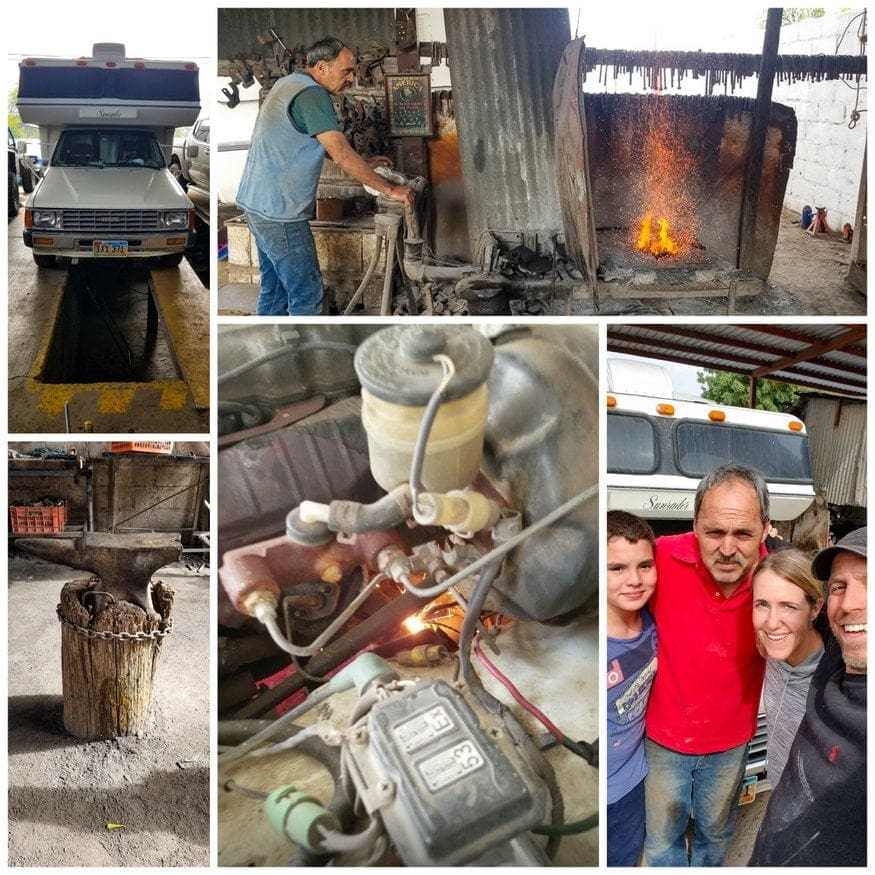
As we were approaching the Mexicali border, it dawned on us that Mexico has some of the best and most affordable mechanics, and we’d be remiss not to get a little more work done. We pulled into Super Mofles to weld a crack in our manifold downpipe, partly because it was a good deal, but also because auto shops had proved to be a priceless opportunity for cultural exchange.
When we got our leaf springs done at Muelles Verdugo in La Paz, we felt so fortunate to spend the day with a pair of brothers in a medieval-style blacksmith shop passed down from their father, where they were literally reshaping metal with a coal fire, an anvil, and brute force.
We bonded and as a tip, we gave their adorable son my old Razor scooter and them a six-pack of beer so we could raise a glass to their incredible work. All told we got a new muffler ($55), catalytic converter ($100), welded manifold downpipe ($10), oil change ($5), rebuilt front sway bar + bushings ($25), four new leaf springs (quoted at $1,100 in the US and $180 in Mexico), and an even better Buddy the Camper. From the Verdugo brothers’ welding to Lupita’s luncheonette, the warmth of the Mexican people is as strong as the sunshine.
RVing Baja, Mexico: Planning and Packing
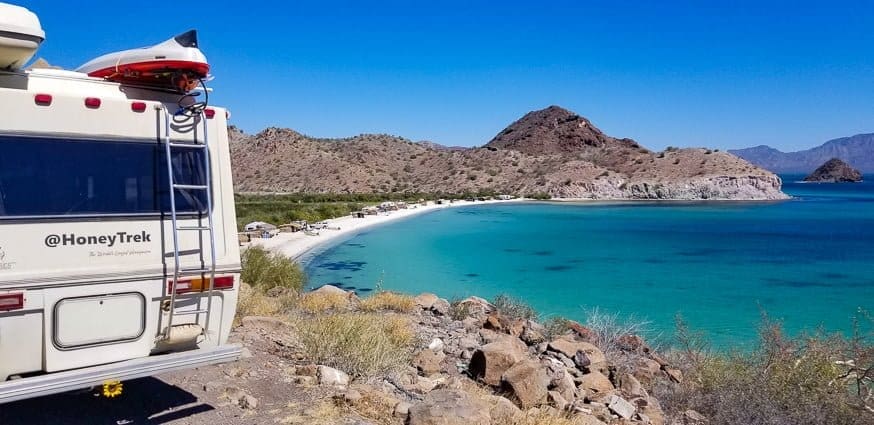
We love Baja and hope you fell in love with it too. Looking forward to your thoughts and questions in the comments below!
